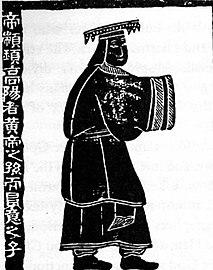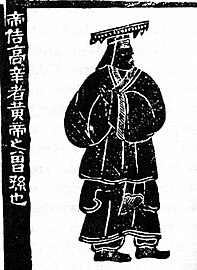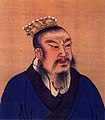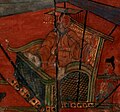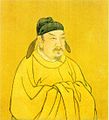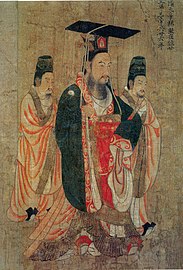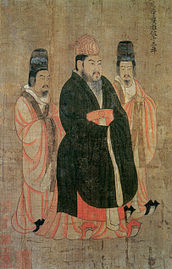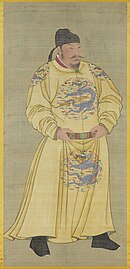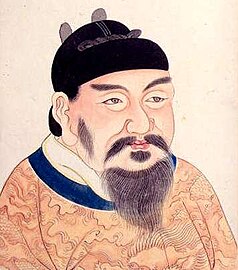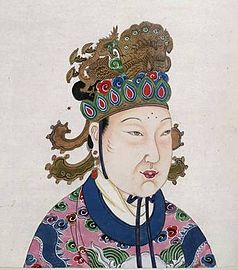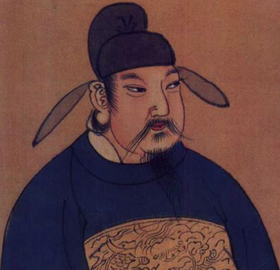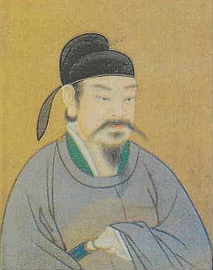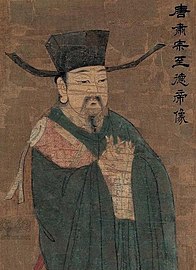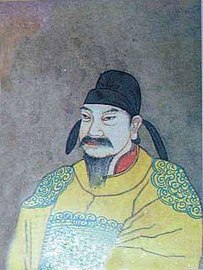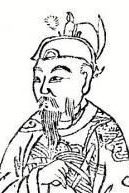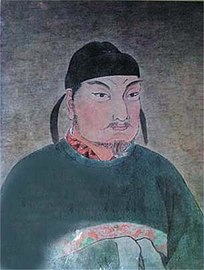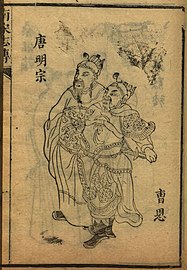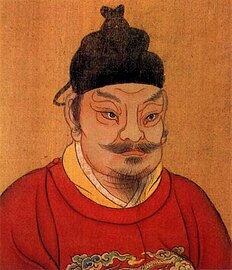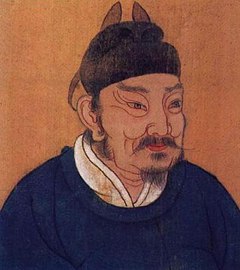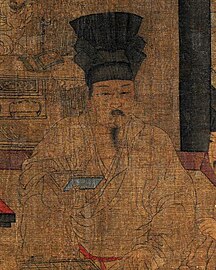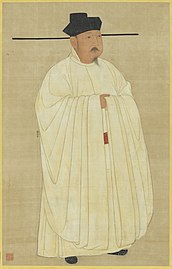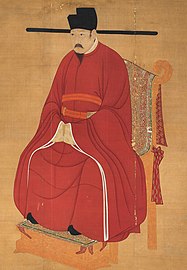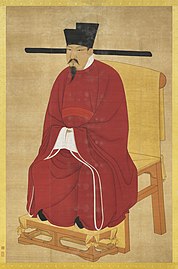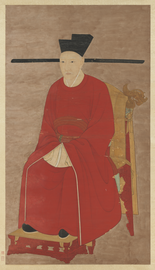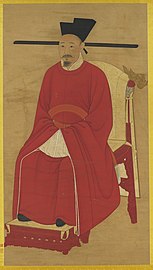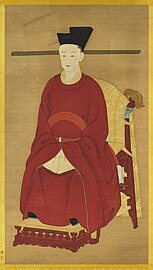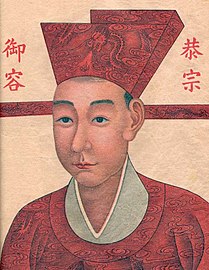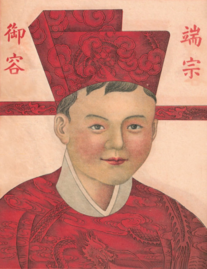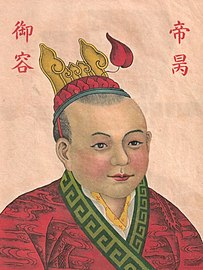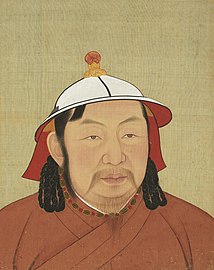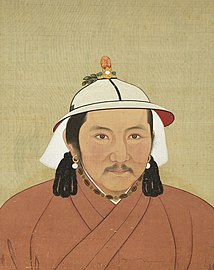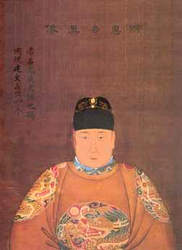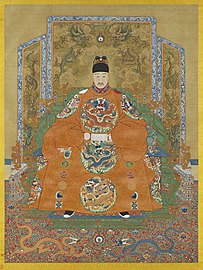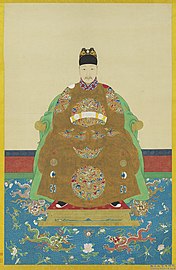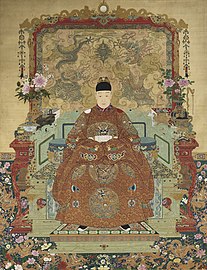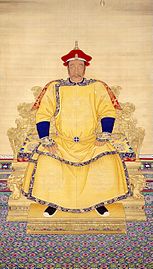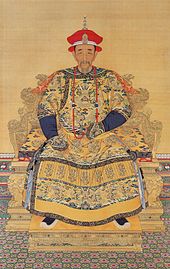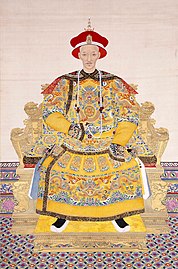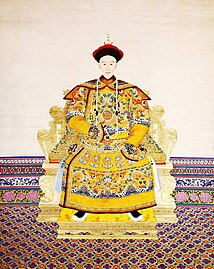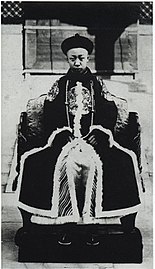Emperor of China
| Emperor ofChina | |
|---|---|
| Hoàng đế | |
Imperial | |
 | |
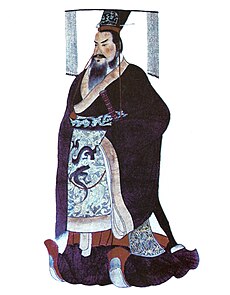 Qin Shi Huang,the first emperor of China(r. 221–210 BC)[1] | |
| Details | |
| Style | HisImperial Majesty(Bệ hạ;Bìxià) |
| First monarch | Qin Shi Huang |
| Last monarch | Puyi |
| Formation | 221 BC(2244–2245 years ago) |
| Abolition | 12 February 1912(112 years ago) |
ThroughoutChinese history,"Emperor"(Chinese:Hoàng đế;pinyin:Huángdì) was the superlative title held by themonarchswho ruled various imperialdynastiesorChinese empires.In traditional Chinese political theory, the emperor was the "Son of Heaven",anautocratwith thedivine mandateright to ruleall under Heaven.Emperors were worshiped posthumously under animperial cult.The lineage of emperors descended from a paternal family line constituted adynasty,andsuccessionin most cases theoretically followedagnatic primogeniture.
During theHan dynasty,Confucianismgained sanction as the official political theory. The absolute authority of the emperor came with a variety of governing duties and moral obligations; failure to uphold these was thought to remove the dynasty'sMandate of Heavenand to justify its overthrow. In practice, emperors sometimes avoided the strict rules of succession and dynasties' purported "failures" were detailed inofficial historieswritten by their successful replacements or even later dynasties. The power of the emperor was also limited by theimperial bureaucracy,which was staffed byscholar-officials,andeunuchsduring some dynasties. An emperor was also constrained byfilial obligationsto his ancestors' policies and dynastic traditions, such as those first detailed in theMing-eraHuang-Ming Zuxun(Ancestral Instructions).
Origin and history[edit]

During theWestern Zhoudynasty (c. 1046 BC– 771 BC), Chinesevassal rulerswith power over theirparticular fiefdomsserved a strong central monarch. Following a brutal succession crisis and relocation of the royal capital, the power of theZhou kings(Vương;wàng[a]) waned, and during theEastern Zhouperiod, the regional lords overshadowed the king and began to usurp that title for themselves. In 221 BC, after the King ofQincompleted the conquest of the various kingdoms of theWarring States period,he adopted a new title to reflect his prestige as a ruler greater than the rulers before him. He called himself "Shi Huangdi", or the 'First Emperor'. Before this,Huang(Hoàng'august', 'sovereign'[b]) was most commonly seen as a reverential epithet for a deceased ancestor, andDi(Đế,OC:*tˤeks) was an apical ancestor, originally referring tothe deified ancestorsof theShangkings.[3][c]In the 3rd century BC, the two titles had not previously been used together. The emperor of China, like the Zhou kings before him, and the Shang kings before them, was most commonly referred to asTianzi(Thiên tử'Son of Heaven'), who wasdivinely appointedto rule. The appellationHuangdicarried similar shades of meaning.[4]Alternate English translations of the word include "The August Ancestor", "The Holy Ruler", or "The Divine Lord". On that account, some modern scholars translate the title as "thearch".[3]
On occasion, the father of the ascended emperor was still alive. Such an emperor was titled as theTaishang Huang('grand imperial sire'). The practice was initiated by Qin Shi Huang, who gave the title as aposthumous nameto his own father, as was already common for monarchs of any stratum of power.Liu Bang,who established theHan dynasty,was the first to become emperor while his father yet lived. It was said he granted the title during his father's life because he would not be done obeisance to by his own father, a commoner.[5][6]
Owing to political fragmentation, over the centuries, it has not been uncommon to have numerous claimants to the title of "Son of Heaven". The Chinese political concept of theMandate of Heavenessentially legitimized those claimants who emerged victorious. The proper list was considered those made by theofficial dynastic histories;thecompilation of a historyof the preceding dynasty was considered one of the hallmarks of legitimacy, along with symbols such as theNine Dingor theHeirloom Seal of the Realm.As with the First Emperor, it remained very common to grant posthumous titles to the ancestors of the victors.
TheYuanandQingdynasties were founded by successful invaders of different ethnic groups. As part of their rule over China, they also went through the culturally appropriate rituals of formally declaring a new dynasty and taking on the Chinese title ofHuangdi,in addition to the titles of their respective people, especially in the case of the Yuan dynasty. Thus,Kublai Khanwas simultaneouslykhaganof theMongolsand emperor of China.
End of the imperial system[edit]
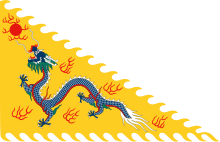
In 1911, the title ofPrime Minister of the Imperial Cabinetwas created to rule alongside the emperor, as part of an attempt to turn China into aconstitutional monarchy.
Puyi,who had reigned as the Xuantong Emperor, abdicated on 12 February 1912, ending the Qing dynasty as well as the imperial tradition altogether, after more than 2100 years.Yuan Shikai,formerPresident of the Republic of China,attempted torestore dynastic rulewith himself as the Hongxian Emperor, however his claim to the title of emperor ended on 22 March 1916. Puyi wasbriefly restoredfor almost two weeks during a coup in 1917 but was overthrown again shortly after. He later became the emperor ofManchukuo,aJapanesepuppet state, and was captured by theRed Armyas a prisoner of war afterWorld War IIand held in the Siberian city ofChita.He was returned to China by the Soviets, and imprisoned inFushun War Criminals Management Centre,and after he was released lived until 1967.
Had the Qing dynasty continued as an imperial house,Jin Yuzhangwould currently head it. He has worked for various local councils on China, and no interest in the restoration of monarchy.[7]
Enumeration[edit]
Traditional political theory holds that there can only be one legitimate Son of Heaven at any given time. However, identifying the "legitimate" emperor during times of division is not always uncontroversial, and therefore the exact number of legitimate emperors depends on where one stands on a number of succession disputes. The two most notable such controversies are whetherCao WeiorShu Hanhad legitimacy during theThree Kingdoms,and at what point theSong dynastyceased to be the legitimate dynasty in favor of theYuan dynasty.[8]The Qing view, reported to Europe by the Jesuits, was that there had been 150 emperors from the First Emperor to theKangxi Emperor.[9]Adding the eight uncontroversial emperors that followed the Kangxi Emperor would give a grand total of 158 emperors from the First Emperor to Puyi.
By one count, from theQin dynastyto theQing dynasty,there were a total 557 individuals who at one point or another claimed the title of Emperor, including several simultaneous claimants at various times.[10]Some, such asLi Zicheng,Huang Chao,andYuan Shu,declared themselves the emperors,Son of Heavenand founded their own empires as a rival government to challenge the legitimacy of and overthrow the existing emperor. Among the most famous emperors wereQin Shi Huangof theQin dynasty,emperorsGaozuandGuangwuof the Han,Emperor Taizong of Tangof the Tang,Kublai Khanof the Yuan, theHongwu Emperorof the Ming, and theQianlong Emperorof the Qing.[11]
Power[edit]
The emperor's words were considered sacred edicts (Thánh chỉ;Thánh chỉ), and his written proclamations were called 'directives from above' (Thượng dụ;Thượng dụ). In theory, the emperor's orders were to be obeyed immediately. He was elevated above all commoners, nobility and members of the Imperial family. Addresses to the emperor were always to be formal and self-deprecatory, even by the closest of family members.
In practice, however, the power of the emperor varied between different emperors and differentdynasties.Generally, in the Chinesedynastic cycle,emperors founding a dynasty usually consolidated the empire through comparativeautocracy—examples include Qin Shi Huang, emperors Gaozu and Guangwu of Han, Emperor Taizong of Tang,Kublai Khanof the Yuan, and theKangxi Emperorof the Qing.
The usual method for widespread geographic power consolidation was to involve the whole family. From generation to generation, the bonds weakened between the branches of family established as local rulers in different areas. After a sufficient period of time, their loyalty could no longer be assured, and the taxes they collected sapped the imperial coffers. This led to situations like the reign ofEmperor Wu of Han,who disenfranchised and annihilated the nobilities of virtually all imperial relatives whose forebears had been enfeoffed by his own ancestor, Gaozu.[12]: 76–84
Apart from a few very energetic monarchs, the emperor usually delegated the majority of decision making to the civil bureaucracy (chiefly thechancelleryand theCentral Secretariat), the military, and in some periods thecensorate.Paranoid emperors, like Emperor Wu of Han and the Ming'sHongwu Emperor,would cycle through high government officials rapidly, or simply leave top-ranking posts vacant, such that no one could threaten their power. During other reigns, certain officials in the civil bureaucracy wielded more power than the emperor himself.[13]
The emperor's position, unless deposed in a rebellion, was always hereditary, usually byagnatic primogeniture.As a result, many emperors ascended the throne while still children. Duringminority reigns,theEmpress Dowager,the emperor's mother, would usually possess significant political power, along with themale members of her birth family.In fact, the vast majority of female rulers throughout Chinese Imperial history came to power by ruling asregentson behalf of their sons; prominent examples includeEmpress Lü Zhiof the Han, as well as the empress dowagersCixiandCi'anduring the Qing, who for a time ruled jointly as co-regents. Where Empresses Dowager were too weak to assume power, or her family too strongly opposed, court officials often seized control. Courteunuchshad a significant role in the power structure, as emperors often relied on a few of them as confidants, which gave them access to many court documents. In a few places, eunuchs wielded vast power; one of the most powerful eunuchs in Chinese history wasWei Zhongxianduring the Ming. Occasionally, other nobles seized power as regents.
The actual area ruled by the emperor of China varied from dynasty to dynasty. In some cases, such as during theSouthern Song dynasty,political power in East Asia was effectively split among several governments; nonetheless, thepolitical fictionthat there was but one ruler was maintained.
Heredity and succession[edit]
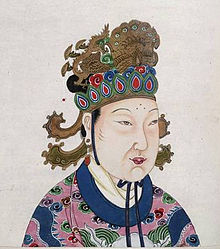
The title ofemperorwas hereditary, traditionally passed on from father to son in each dynasty. There are also instances where the throne is assumed by a younger brother, should the deceased emperor have no male offspring. By convention in most dynasties, the eldest son born to theEmpress consort(Đích trường tử;Đích trường tử) succeeded to the throne. In some cases when the empress did not bear any children, the emperor would have a child with another of his many wives (all children of the emperor were said also to be the children of the empress, regardless of birth mother). In some dynasties the succession of the empress' eldest son was disputed, and because many emperors had large numbers of progeny, there were wars of succession between rival sons. In an attempt to resolve after-death disputes, the emperor, while still living, often designated a crown prince (Thái tử). Even such a clear designation, however, was often thwarted by jealousy and distrust, whether it was the crown prince plotting against the emperor, or brothers plotting against each other. Some emperors, like theYongzheng Emperor,after abolishing the position of Crown Prince, placed the succession papers in a sealed box, only to be opened and announced after his death.
Unlike, for example, the Japanese monarchy, Chinese political theory allowed for a change in the ruling house. This was based on the concept of the "Mandate of Heaven".The theory behind this was that the Chinese emperor acted as the" Son of Heaven "and held a mandate to rule over everyone else in the world; but only as long as he served the people well. If the quality of rule became questionable because of repeated natural disasters such as flood or famine, or for other reasons, then rebellion was justified. This important concept legitimized the dynastic cycle or the change of dynasties. This principle made it possible even for peasants to found new dynasties, as happened with the Han and Ming dynasties, and for the establishment ofconquest dynastiessuch as the Mongol-led Yuan dynasty and Manchu-led Qing dynasty. It was moral integrity and benevolent leadership that determined the holder of the "Mandate of Heaven".
There has been only one lawfulqueen regnantin Chinese history,Wu Zetian,who briefly replaced theTang dynastywith her ownWu Zhou dynasty.Many women, however, did become de facto leaders, usually asEmpress Dowager.Prominent examples includeEmpress Dowager Lüof the Han,Empress Liuof theSong,and Empress Dowager Cixi of the Qing.
Styles, names and forms of address[edit]
As the emperor had, by law, an absolute position not to be challenged by anyone else, his or her subjects were to show the utmost respect in his or her presence, whether in direct conversation or otherwise. When approaching the imperial throne, one was expected tokowtowbefore the emperor. In a conversation with the emperor, it was considered a crime to compare oneself to the emperor in any way. It wastabooto refer to the emperor by his or her given name, even for the emperor's own mother, who instead was to useHuangdi(Hoàng đế), or simplyEr(Nhi;Nhi'son', for a male emperor). The given names of all the emperor's deceased male ancestors were forbidden from being written, and were avoided (Tị húy) by the use of synonyms, homophones, or leaving out the final stroke of the taboo character. This linguistic feature can sometimes be used to date historical texts, by noting which words in parallel texts are altered.
The emperor was never to be addressed asyou.Instead, one usedBixia(Bệ hạ'bottom of the steps'), corresponding to "Your Imperial Majesty",Huangshang,Shengshang(Thánh thượng;Thánh thượng'holy highness') orTianzi(Thiên tử'Son of Heaven'). The emperor was also alluded to indirectly through reference to theimperial dragon symbology.Servants often addressed the emperor asWansuiye(Vạn tuế gia;Vạn tuế gia'lord often thousand years'). The emperor referred to himself aszhen(Trẫm), the original Chinese first-person singular pronoun arrogated by Qin Shi Huang, functioning as an equivalent to theroyal we.In front of subjects, the emperor may also refer to themselves self-deprecatingly asGuaren(Quả nhân'the morally-deficient one') orGu(Cô'lonely one').
In contrast to the Western convention of using a regnal or personal name (e.g. George V) to refer to a sovereign, the emperor was referred to in the third person simply asHuangdi Bixia(Hoàng đế bệ hạ'His Majesty the Emperor') orDangjin Huangshang(Đương kim hoàng thượng;Đương kim hoàng thượng'present emperor above'). Under the Qing, the emperor was usually styled 'His Imperial Majesty the Emperor of the Great Qing Dynasty,Son of Heaven,Lord ofTen Thousand Years', though this varied considerably. In historical texts, the present emperor was almost universally referred to asShang(Thượng).
Generally, emperors also ruled with anera name(Niên hào;Niên hào). Since the adoption of era names byEmperor Wu of Hanand up until theMing dynasty,the sovereign conventionally changed the era name semi-regularly during his or her reign. During the Ming and Qing dynasties, emperors simply chose one era name for their entire reign, and people often referred to past emperors with that title. In earlier dynasties, the emperors were known with atemple namegiven after their death. Most emperors were also given aposthumous namewhich was sometimes combined with the temple name (e.g. Emperor Shengzu RenThánh tổ nhân hoàng đế;Thánh tổ nhân hoàng đếfor the Kangxi Emperor). The passing of an emperor was referred to asJiabeng(Giá băng;Giá băng'collapse of the imperial chariot') and an emperor that had just died was referred to asDaixing Huangdi(Đại hành hoàng đế'the emperor of the great journey').
Consorts and children[edit]
The imperial family was made up of the emperor and the empress (Hoàng hậu) as the primary consort and Mother of the Nation (Quốc mẫu;Quốc mẫu). In addition, the emperor would typically have several other consorts andconcubines(Tần phi;Tần phi), ranked by importance into aharem,in which the Empress was supreme. Every dynasty had its set of rules regarding the numerical composition of the harem. During the Qing dynasty, for example, imperial convention dictated that at any given time there should be oneEmpress,oneImperial Noble Consort,twoNoble Consort,fourConsortand sixConcubine,plus an unlimited number ofNoble Lady,First Class AttendantandSecond Class Attendant.Although the emperor had the highest status by law, by tradition and precedent theempress dowager(Hoàng thái hậu) usually received the greatest respect in the palace and was the decision maker in most family affairs. At times, especially when a young emperor was on the throne, she was the de facto ruler. The emperor's children, the princes (Hoàng tử) and princesses (Công chủ), were often referred to by their order of birth—e.g. Eldest Prince or Third Princess. Princes were often given titles of peerage once they reached adulthood. The emperor's brothers and uncles served in court by law, and held equal status with other court officials (Tử). The emperor was always elevated above all others despite any chronological or generational superiority.
Ethnicity[edit]
Recent scholarship is wary of applying present-dayethnic categoriesto historical situations. Most Chinese emperors have been considered members of theHan ethnicity,but there were also many Chinese emperors who were of non-Han ethnic origins. The most successful of these were theKhitansof theLiao dynasty,theJurchensof theJin dynasty (1115–1234),who later ruled theQing dynastyas theManchus,and the Mongols of the Yuan dynasty. The orthodox historical view sees these as dynasties assinicizedpolities as they adopted Han culture, claimed theMandate of Heaven,and performed the traditional imperial obligations such as annual sacrifices to Heaven for rain and prosperity. The revisionistNew Qing Historyschool, however, argues that the interaction between politics and ethnicity was far more complex and that elements of these dynasties differed from and altered "native Chinese" traditions concerning imperial rule.[14]
Gallery[edit]
Early dynasties and Qin[edit]
Han, Xin and Three Kingdoms[edit]
-
Emperor Gaozu of Han(256 –195 BC)
-
Emperor Wen of Han(202 –157 BC)
-
Emperor Jing of Han(188 BC –141 BC)
-
Emperor Wu of Han(156 –87 BC)
-
Emperor Zhao of Han(94 –74 BC)
-
Emperor Xuan of Han(91 –49 BC)
-
Emperor Yuan of Han(75 –33 BC)
-
Emperor Cheng of Han(51 –7 BC)
-
Emperor Ai of Han(27 –1BC)
-
Emperor Guangwu of Han(5 BC–57 AD)
-
Emperor Ming of Han(28– 7 5AD)
-
Emperor Zhang of Han(56– 88)
-
Emperor Xian of Han(181–234)
-
Emperor Wen of Wei(187–226)
-
Emperor Da of Eastern Wu(182–252)
-
Emperor Zhaolie of Shu Han(162–223)
-
Emperor He of Han(79 – 13 February 106)
-
Emperor Mo of Sun Wu(243 – January or February 284)
-
King Wushun of Huaiyang(died 25)
-
Wang Mang(45 BCE-23 CE)
-
Liu Shan(207-271)
Jin and Northern and Southern dynasties[edit]
-
Emperor Wu of Jin(236–290)
-
Emperor An of Jin(382-419)
-
Emperor Hui of Jin(259/260-307)
-
Emperor YuanofEastern Jin(276-323)
-
Emperor WuofLiu Song(363–422)
-
Emperor Gao of Southern Qi(427–482)
-
Emperor Wu of Liang(464–549)
-
Emperor Wu of Chen(503–559)
-
Emperor Xuan of Chen(530–582)
-
Emperor Wen of Chen(522–566)
-
Emperor Fei of Chen(554–570)
-
Emperor Houzhu of Chen(553–604)
-
Emperor WenxuanofNorthern Qi(526–559)
-
Emperor WuofNorthern Zhou(543–578)
-
Emperor Xiaowu of Song(19 September 430 – 12 July 464)
-
Emperor Daowu of Northern Wei(371–409)
-
Emperor Xiaozhuang of Northern Wei(507-531)
-
Emperor Wencheng of Northern Wei(July or August 440 – 20 June 465)
-
Emperor Xiaowen of Northern Wei(October 13, 467 – April 26, 499)
-
Emperor Mingyuan of Northern Wei(392 – 24 December 423)
-
Emperor Min of Jin(300-318)
-
Emperor Huai of Jin(284-313)
Sui dynasty[edit]
-
Emperor Wen of Sui(541–604)
-
Emperor Yang of Sui(569–618)
Tang dynasty[edit]
-
Emperor Gaozu of Tang(566–635)
-
Emperor Taizong of Tang(598–649)
-
Emperor Gaozong of Tang(628–683)
-
EmpressWu Zetianof theZhou dynasty(690–705)
-
Emperor Zhongzong of Tang(656–710)
-
Emperor Ruizong of Tang(662–716)
-
Emperor Xuanzong of Tang(685–762)
-
Emperor Shengwu of Yan(703–757)
-
Emperor Suzong of Tang(711–762)
-
Emperor Daizong of Tang(727–779)
-
Emperor Dezong of Tang(742–805)
-
Emperor Xianzong of Tang(778–820)
-
Emperor Muzong of Tang(795–824)
-
Emperor Jingzong of Tang(809–827)
-
Emperor Wenzong of Tang(809–840)
-
Emperor Wuzong of Tang(814–846)
-
Emperor Xuanzong of Tang(810–859)
-
Emperor Yizong of Tang(833–873)
-
Emperor Xizong of Tang(862–888)
-
Emperor Zhaozong of Tang(867–904)
Five dynasties[edit]
-
Wang Jian (Former Shu)(847 – July 11, 918)
-
Wang Yanzheng(died 951)
Northern Song dynasty[edit]
-
Zhao Hongyin,posthumously made emperor by his son, the first emperor of theSong dynasty
-
Emperor Taizu of Song(927–976)
-
Emperor Taizong of Song(939–997)
-
Emperor Zhenzong of Song(968–1022)
-
Emperor Renzong of Song(1010–1063)
-
Emperor Yingzong of Song(1032–1067)
-
Emperor Shenzong of Song(1048–1085)
-
Emperor Zhezong of Song(1077–1100)
-
Emperor Huizong of Song(1082–1135)
-
Emperor Qinzong of Song(1100–1161)
Southern Song dynasty[edit]
-
Emperor Gaozong of Song(1104–1187)
-
Emperor Xiaozong of Song(1127–1194)
-
Emperor Guangzong of Song(1147–1200)
-
Emperor Ningzong of Song(1168–1224)
-
Emperor Lizong of Song(1205–1264)
-
Emperor Duzong of Song(1240–1274)
-
Emperor Gong of Song(1271–1323)
-
Emperor Duanzong(1270–1278)
-
Zhao Bing(1272–1279)
Yuan dynasty[edit]
-
Kublai Khan(1215–1294)
-
Temür Khan(1265–1307)
-
Külüg Khan(1281–1311)
-
Ayurbarwada Buyantu Khan(1285–1320)
-
Jayaatu Khan Tugh Temür(1304–1332)
-
Rinchinbal Khan(1326–1332)
Ming dynasty[edit]
Qing dynasty[edit]
Empire of China[edit]
-
Yuan Shikaias the Hongxian Emperor of China (1915–1916)
See also[edit]
- Chinese emperors family tree
- Tributary system of China
- List of Chinese monarchs
- Dragon Throne
- Taishang Huang– an honorific for a retired emperor
- Celestial Empire
- Chinese Empire
- Khan of Heaven
- Emperor at home, king abroad
Notes[edit]
- ^*ɢʷaŋ,[2]
- ^*ɢʷˤaŋ
- ^Huang(Hoàng) andDi(Đế) were also terms applied to theThree Sovereigns and Five Emperors,mythical godly rulers and culture heroes credited with feats like ordering theskyand forming the first humans out of clay, as well as the invention of agriculture,clothing,astrology,music,etc.
References[edit]
- ^Dillon, Michael, ed. (2017).Encyclopedia of Chinese History.Routledge. p. 182.ISBN978-0-415-42699-2.
- ^Baxter, William & al.Baxter–Sagart Old Chinese ReconstructionArchivedSeptember 27, 2013, at theWayback Machine.2011. Accessed 22 Dec 2013.
- ^abNadeau, Randall L.The Wiley-Blackwell Companion to Chinese Religions,pp. 54 ff.John Wiley & Sons (Chichester), 2012. Accessed 22 December 2013.
- ^Harrison, Thomas; Blanshard, Alastair;Bryce, Trevor;Coningham, Robin;Jenner, W. J. F.; Kaizer, Ted;Llewellen-Jones, Lloyd;Manley, Bill; Manuel, Mark (2009). Harrison, Thomas (ed.).The Great Empires of the Ancient World.Los Angeles:Getty Publications.p. 254.ISBN978-0-89236-987-4.
- ^Sima Qian,Records of the Grand Historian,"Gaozu's Basic Annals",61
- ^Sima Qian (author) & Burton Watson (translator) (1971).Records of the Grand Historian of China"Volume I: The Early Years of the Han dynasty from 209 to 141 B.C. Part III: The Victor - The Basic Annals of Emperor Kao-tsu (Shih-chi 8)" p. 108-109.
- ^"Just call me Jin, says the man who would be emperor".Sydney Morning Herald.Nine Entertainment. 27 November 2004.Retrieved2 October2022.
- ^Wilkinson, Endymion. (2018). Chinese History, a New Manual. Pp 9-8, 684
- ^Intorcetta, Prospero. (1687). Confucius Sinarum Philosophus
- ^Barmé, Geremie (2008).The Forbidden City.Harvard University Press. p. 594.ISBN978-0-674-02779-4.
- ^"Khán bản đồ học trung quốc lịch sử", p.5, Publisher: Chung Hwa Book Company, Year: 2006, Author: Lục vận cao,ISBN962-8885-12-X.
- ^Nylan, Michael(2016). "Mapping Time in theShijiandHanshuTables ".East Asian Science, Technology, and Medicine.43(43). Brill: 61–122.doi:10.1163/26669323-04301004.JSTOR90006244.S2CID171943719.
- ^Hucker, Charles O.(1985).A Dictionary of Official Titles in Imperial China.Stanford: Stanford University Press. pp. 4–102.ISBN978-957-638-285-7.
- ^Sinicization vs. Manchuness: The Success of Manchu Rule
Further reading[edit]
- Paludan, Ann (1998).Chronicle of the Chinese Emperors: The Reign-by-Reign Record of the Rulers of Imperial China.New York: Thames and Hudson.ISBN0-500-05090-2.



